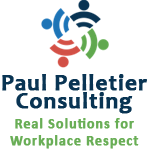by paulpell | Dec 31, 2015 | Articles, Workplace Bullying
Paul’s book – “Workplace Bullying – It’s Just Bad for Business” will be available in early January 2016. The book approaches workplace bullying from a business perspective, identifying the range of challenges and impacts that ripple through any organization. Designed as a handbook, it contains bullying prevention, management, and elimination strategies for organizations and everyone else.
Combining helpful statistics and research with practical information, the book provides implementable action plans for anyone impacted by bullying, regardless of industry, sector, or role. Whether you are an executive, a manager, a coworker, a target or a team leader, “Workplace Bullying – It’s Just Bad for Business” is an invaluable tool for coping with bullying in your organization.
Stay tuned for launch details.

by paulpell | Dec 22, 2015 | Presentations, Workplace Bullying
I’m delighted to share that I found out that my proposal, “Coping Strategies for Project Managers Dealing with Workplace Bullies” has been selected for presentation at the PMI Global Congress 2016 – EMEA to be held in Barcelona, Spain from 09 – 11 May 2016.
What an honour!

PMI Global Congress – EMEA 2016
by paulpell | Dec 22, 2015 | Articles, Workplace Bullying
A December 2015, Huffington Post article discusses strategies for effectively approaching management about a workplace bullying problem. Here is the critical advice:
“To get powerful figures on your side, you have to build genuine, trusting relationships with them first. The secret is to appeal to their interests. That’s right. If you want management to “tune into” workplace bullying, make sure you’re broadcasting on their favourite station: WIFM (What’s In It For Me?). What I mean is that you have make the case that helping you will help them too.”
In my experience, this is very helpful advice and plays a significant role in the likelihood of success when filing a complaint about your workplace or project bully.

Workplace Bullying
by paulpell | Dec 10, 2015 | Inclusion and Diversity

Forbes recently released Fostering Innovation Through a Diverse Workforce. The paper is based on an exclusive survey of 321 executives at large global enterprises ($500 million-plus in annual revenues).
One of the key findings is that, for global companies, diversity is no longer simply a matter of creating a heterogeneous workforce, but using that workforce to innovate and give it a competitive advantage in the marketplace. And as companies compete on a global scale, diversity and inclusion frequently have to shift, as different markets and different cultures have varied definitions of what diversity means.
What do you think?
by paulpell | Dec 3, 2015 | Inclusion and Diversity
I often get asked “what are the tangible benefits of investing in a diversity program?” According to American Express, here are the top advantages of workplace diversity:
- It builds your employer brand. Having a diverse workforce makes your company more interesting, people can expect to learn more from your employees and you can attract better talent from around the world.
- It increases creativity. When you bring a variety of different people from various backgrounds together, you’ll end up getting better solutions to business problems.
- It encourages personal growth. This is a major advantage to workplace diversity because it can help employees learn new ideas, perspectives and connect intellectually and personally to different people.
- It makes employees think more independently. If you have similar people at a company, it will be harder to solve complex problems.






